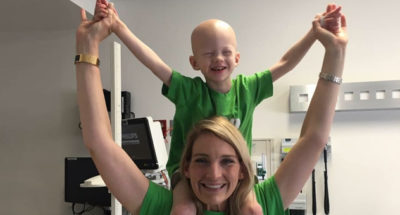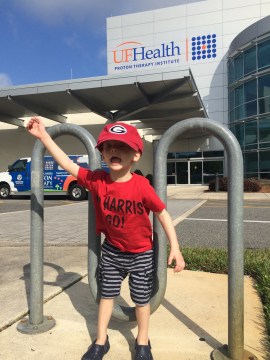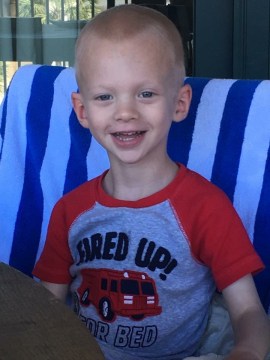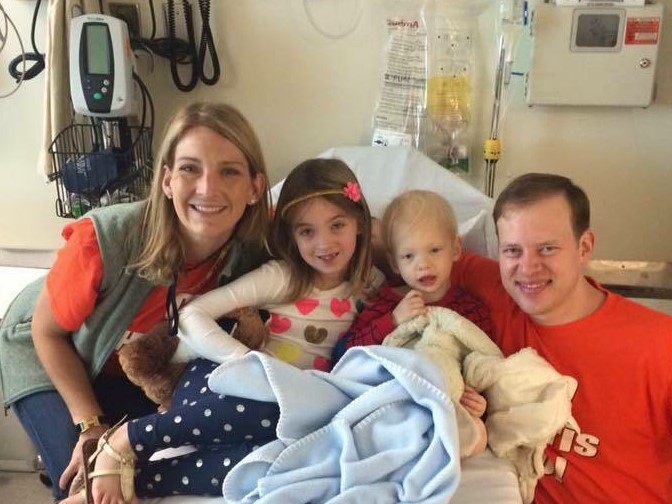GHN Special Report on Child Cancer: Part Two
Jointly reported by Georgia Health News and WebMD
When Harris Lott was diagnosed with cancer last summer, the 2-year-old had an asset most children don’t have: Parents who are both doctors.
[youtube]https://youtu.be/mCizhUiDZnw[/youtube]McGregor Lott, MD, and Mary Elizabeth Lott, MD, practice in the southeast Georgia town of Waycross, a few miles north of Florida. He’s an ophthalmologist and she’s a pediatrician. They met at medical school in Augusta, GA.
Harris was one of four children in the Waycross area diagnosed with rare cancers. He and two of the others have a type known as rhabdomyosarcoma, a cancer that starts in the body’s soft tissues, usually muscles.
When their son was diagnosed, the Lotts knew how the science worked and where to go for answers.
When asked whether it was a benefit for them to be doctors, having a child with cancer, Mary Elizabeth Lott says, “I think it was helpful, that we were able to ask more questions” about possible treatments.
But as doctors, the couple also had a stark understanding of the perils their son was facing.
They knew what kind of damage the disease could wreak. And beyond concerns about his survival, they were aware of the possible side effects of treatment. Those can include delayed growth; heart, lung, or endocrine issues; and fertility problems.

“We knew the long-term issues,” Mary Elizabeth Lott says.
They also had concerns typical for any family hit by cancer. “When your child is diagnosed, you have to figure out how to make it” as a family, says McGregor Lott.
Mary Elizabeth Lott, who was already working part-time, cut further back on her pediatric practice and became Harris’ primary caregiver. They also have a daughter, 6-year-old Candler.
“If he got sick,” she says, “I had to cancel clinics.” Her employer, McKinney Medical Center, has been very understanding, she says.
Meanwhile, McGregor Lott had to “try to keep the fires burning” through his own practice. It’s the source of the family’s health insurance, which has been crucial as Harris’ medical costs have continued to pile up.
Weighing the risks

Harris had chemotherapy for 10 1/2 months. After the first 3 months, doctors recommended radiation therapy at University of Florida Health in Jacksonville.
The regimen, created at St. Jude Children’s Research Hospital in Memphis, TN, called for 33 radiation treatments. Harris was put under for every one of them, his mother says. Doing it that way increased his survival chances but also increased the risk of side effects, the Lotts say.
The couple got second opinions from both St. Jude’s and Mayo Clinic, where the doctors agreed with their course of action.
Harris’ radiation treatments went from the middle of October through the first week of December 2015.
“Our son was offered a rare opportunity to be on a St. Jude clinical study while being able to stay at home,” Mary Elizabeth Lott says.
In some ways, Harris’ age “made it easier” to go through treatment, she says. “He didn’t complain. He didn’t know what was at stake.”
During his cancer battle, the couple connected on Facebook with the other families dealing with the disease.
“All of us were focused on our child,” Mary Elizabeth Lott says.
“In a weird way, it was kind of comforting,” she says now. “Your heart breaks for all of the families. There is some comfort in numbers.”
She says that “every parent whose child gets cancer questions themselves: ‘Why my child?’ You question whether you made a bad decision.”
But the fact that three other childhood cancers occurred nearby led the Lotts to conclude that nothing they had done was likely to have caused their son’s illness.
Harris’ cancer doctor agreed, telling the couple that while it was natural to question themselves, there was no reason to because there is no known cause of rhabdomyosarcoma.
Still, it’s hard not to wonder how such an illness could strike a child. “We think about it all the time,” Mary Elizabeth Lott admits.
Coincidence or pattern?

McGregor Lott, who grew up in Waycross, says one of their first thoughts was: How can this be happening to our community?
The number of child cancer cases in the Waycross area has raised some eyebrows. But the Lotts say they’ve seen no evidence yet that environmental factors played any part in these cases. Public health officials are trying to figure out whether their cases are unusual compared to the rest of the country, but don’t yet have all the data needed to make that determination.
Harris recently stopped getting chemotherapy. The mass in his body has shrunk, from about 10 centimeters in the initial scan down to 1.9.
His mother says Harris, who just turned 4, has had “a very positive response” to the treatments. His doctors say that he’s had as good a response as they could have hoped. He’s still receiving chemotherapy maintenance drugs, and his parents say his outlook is good.
His energy level is now up to about 75 percent of normal. Though he weighs just 28 pounds, his hair is coming back. And he loves the school program he attends.
The side effects of Harris’ radiation treatments are a constant worry for his parents, who understand that one such effect could be a secondary cancer. “This may not be his last battle with cancer,” Mary Elizabeth Lott says.
As was the case with the other children, Harris has inspired people beyond his own household, with relatives and friends rallying around him and his parents.
These supporters even have a slogan: “Go Harris Go.” On days when he received chemotherapy, they wore specially made T-shirts bearing the phrase.
Such support has made a big difference, his parents say.
“You know you are loved,” Mary Elizabeth Lott says. “The support from family, friends and the community has been unwavering. We have seen so much goodness.”
Here’s a link to Part One of our series, published in collaboration with WebMD
and Part Three (Why are child cancer rates increasing?)
and Part Four (The problem with cancer clusters)

